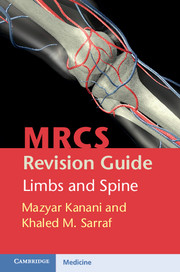6 - Operative surgery
from Section 1 - Basic science
Published online by Cambridge University Press: 05 August 2015
Summary
Carpal tunnel decompression
What are the causes of carpal tunnel syndrome?
Any condition that increases the pressure within the carpal tunnel will lead to compression of the median nerve and thus symptoms of median nerve entrapment. These conditions include:
• Pregnancy,
• Hypothyroidism,
• Acromegaly,
• Rheumatoid arthritis,
• Trauma: this can occur as a complication of a Colles' fracture.
How would you perform a carpal tunnel decompression?
• Obtain informed consent from the patient.
• Mark the arm with a permanent marker.
• Apply tourniquet and infiltrate with local anaesthetic.
• Have the arm laid out onto arm board, supinated, prepared and draped.
• Consider using a ‘lead hand retractor’ to expose the hand and keep it flat.
• Make an incision in line with the third web space, beginning approximately 3 cm distal to the distal wrist crease.
• The incision should not cross the distal wrist crease, to avoid painful scarring.
• Ensure that the incision is perpendicular to the skin at all times.
• A West self-retaining retractor is useful for visualizing the retinaculum as the dissection progresses.
• The median nerve is protected by sliding a MacDonald's elevator immediately beneath the retinaculum.
• The retinaculum is then incised until the palmar arch and the visualization of the palmar fat pad.
• Ensure that the retinaculum is released proximally.
• Achieve haemostasis.
• Close the skin with interrupted nylon sutures.
• Apply dressing and bandages.
What nerves are at risk in this procedure?
Median nerve
Palmar cutaneous branch of the median nerve Passes superficial to the flexor retinaculum on the radial side of palmaris longus and is the sensory supply to the thenar eminence,
Recurrent motor branch of the median nerve Branches radially as the median nerve exits the carpal tunnel, and turns back to give the motor supply the thenar muscles.
Ulnar nerve and ulnar artery If the dissection goes towards the ulnar aspect and into Guyon's canal – thus the emphasis on a straight incision with perpendicular dissection.
Where is the ulnar nerve and is it affected by a carpal tunnel syndrome?
No, the ulnar nerve is not affected in a carpal tunnel syndrome.
- Type
- Chapter
- Information
- MRCS Revision Guide: Limbs and Spine , pp. 112 - 128Publisher: Cambridge University PressPrint publication year: 2012



